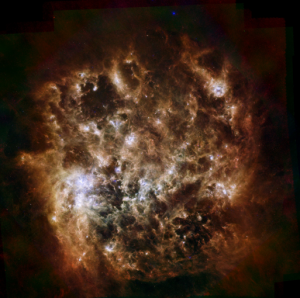
The Large Magellanic Cloud, as imaged by Herschel SPIRE and PACs. Red is SPIRE 250 μm, green is PACS 160 μm, and blue is PACS 100 μm. The image is ~50 deg2 (Meixner et al., 2013).
By observing other galaxies, we can study the global properties of stellar populations and the interstellar medium (ISM) under physical conditions which are different from those of the Milky Way. Results of the first BLAST mission revealed that over half of the far-infrared background light comes from galaxies at z ≥ 1.2 (Devlin et al. 2009). Rather than performing surveys of many distant galaxies, BLAST-TNG will target individual, nearby galaxies, in an attempt to map their magnetic field structure via the polarized thermal emission from dust.
Magnetic fields constitute a significant part of the energy density in galactic ISMs. Through flux freezing and channeling of cosmic ray electrons, they can influence the evolution of structure across all spatial scales within a galaxy. At radio wavelengths, synchrotron emission and Faraday rotation has been used to map the large scale fields in a variety of galaxy types, including spirals, ellipticals, dwarf irregulars and interacting pairs. BLAST-TNG will complement these observations by providing information about the magnetic field direction in the plane-of-the-sky.




